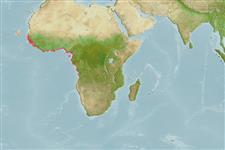Actinopterygii (ray-finned fishes) >
Anguilliformes (Eels and morays) >
Heterenchelyidae (Mud eels)
Etymology: Pythonichthys: Greek, python = the huge serpent or monster slain near Delphi by Apollo in the Greek mithology (1590) Greek, ichthys = fish (Ref. 45335).
Environment / Climate / Range
Ecology
Marine; demersal. Tropical, preferred ?
Eastern Atlantic: Sierra Leone to Angola.
Size / Weight / Age
Maturity: Lm ? range ? - ? cm
Max length : 80.0 cm TL male/unsexed; (Ref. 6534)
Inhabits coastal waters (Ref. 6534).
Life cycle and mating behavior
Maturity | Reproduction | Spawning | Eggs | Fecundity | Larvae
Smith, D.G., 1990. Heterenchelyidae. p. 153-155. In J.C. Quero, J.C. Hureau, C. Karrer, A. Post and L. Saldanha (eds.) Check-list of the fishes of the eastern tropical Atlantic (CLOFETA). JNICT, Lisbon; SEI, Paris; and UNESCO, Paris. Vol. 1. (Ref. 6534)
IUCN Red List Status (Ref. 115185)
CITES (Ref. 94142)
Not Evaluated
Threat to humans
Harmless
Human uses
More information
Common namesSynonymsMetabolismPredatorsEcotoxicologyReproductionMaturitySpawningFecundityEggsEgg development
ReferencesAquacultureAquaculture profileStrainsGeneticsAllele frequenciesHeritabilityDiseasesProcessingMass conversion
Tools
Special reports
Download XML
Internet sources
Estimates of some properties based on models
Phylogenetic diversity index (Ref.
82805): PD
50 = 0.5664 [Uniqueness, from 0.5 = low to 2.0 = high].
Bayesian length-weight: a=0.00102 (0.00046 - 0.00225), b=3.06 (2.88 - 3.24), in cm Total Length, based on all LWR estimates for this body shape (Ref.
93245).
Trophic Level (Ref.
69278): 3.9 ±0.6 se; Based on size and trophs of closest relatives
Resilience (Ref.
69278): .
Vulnerability (Ref.
59153): Low to moderate vulnerability (34 of 100) .
